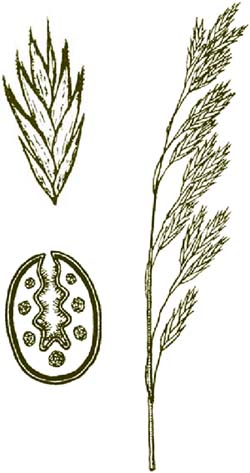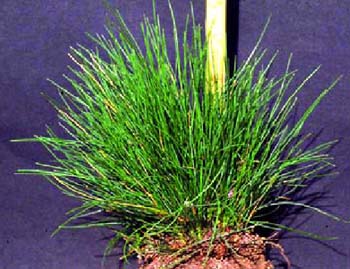Variable fescue

Festuca varia s. str. (Kiffmann, 1978)
BOTANY
Perennial, forming small green mats, numerous intravaginal young shoots, no rhizomes or stolons.
Culms are 25-50 cm high, slim, upper part usually scabrous, glabrous, two glabrous nodes.
Leaf sheaths of young shoots with margins connate in the lower third, mostly puberulous, ending glabrous.
Ligule of young shoots is a 0.5-2 mm long, truncate, mostly disintegrating, membranous fringe; cauline leaves 1-3 mm long.
Leaf blades of young shoots up to 15 cm long, 0.6-1 mm in diameter, glabrous, pointed and stinging, cross-section folded, obovate, seven to nine vascular bundles, adaxially five to seven ribs and usually six grooves, ribs shortly pilose.
Inflorescence a panicle, 3.5-8 cm long, ovate, open, consisting of few spikelets only, lateral branches as well as main axis densely pilose with short hair, lower lateral branches about half as long as panicle.
Four to seven flowered spikelets, 8-11 mm long, coated purple, rachilla scabrous and shortly pilose between florets.
SUITABILITY FOR RESTORATION
Variable fescue is a European montane plant, found in alpine and subalpine areas, but seldom in montane zones. It usually grows in pure stands on fully exposed, steep, southeastern to southwestern upper and middle slopes. Its usual habitat is on dry basement complex rock in the upper forest zone.
It grows preferably on skeletal, deficient in lime ranker, poorly developed brown soils and semipodsols above granite as well as above para - and biotite - gneiss and phyllite with a pH between 4.2 and 6.2. It shows moderate aridity, acidity, low nutritional content, mineral soil and light (heliophyte).
For restoration of acidic, exposed, steep slopes in the subalpine to alpine zone, good protection against solifluction. Low tolerance of cutting. Not suitable for foraging or hay harvest (rigid, pointed leaves).
SEEDS
Glumes almost similar, lower glume oneveined, 3-5 mm long, broadly lanceolate, pointed, upper glume one to three-veined, 3.5-6 mm long, broadly lanceolate to ovate-lanceolate, shortly acuminate with broad, white translucent margins.

Seeds
Lemma five-veined, 4.5-6 mm long, broadly ovate, shortly acuminate, smooth and glabrous, only upper part scabrous to shortly ciliate, membranous, thin membranous margins, pointed or with up to 1.2 mm long awns.
Palea approximately as long as lemma, lanceolate, apically notched.
Thousand seed weight: 0.8-1.1 g.
REQUIREMENTS
(soil and climate)
Festuca varia is very similar to Festuca pseudodura, in appearance as well as cultivation. Variable fescue has no special soil requirements. Moist or waterlogged soil, ground with high weed infestation, peat and light, dry soil should be avoided. Competition with weeds is low. Locations with a high presence of annual meadow grass and rough meadow grass (Poa annua and Poa trivialis) should therefore be avoided.
CULTIVATION
Open sowing is possible if carried out until the end of June at the latest (or beginning of July in mild climates). In the latter case irrigation must be available.
Because of the plant’s slow juvenile development and low competition, cultivation below cover crops in autumn should be avoided.
Seeding in spring under linseed is unproblematic. Because of photosensitivity and slow juvenile development it is important to have a thin cover crop population. Seeding should be done immediately after the seeding of the cover crop.
Seed depth: no more than 0.5 cm.
Seed rate: 8-10 kg/ha.
Row spacing: 15-20 cm. Broadcast seeding is possible.

Single plant
FERTILIZATION
Festuca varia has no special requirements. A low to intermediate supply of nutrients is sufficient for a satisfactory crop yield.
Phosphorus and potassium: for soil with an intermediate supply of phosphorus and potassium, fertilization with stable manure (15-20 tonnes/ha) is sufficient. For mineral fertilization, amounts should be between 50 and 60 kg/ha P2O5 and 80 to 100 kg/ha K2O.
Nitrogen: sufficient nitrogen in autumn guarantees satisfactory tillering. However, a surplus of nitrogen in late spring may decrease the development of spermatophores. The amount of nitrogen necessary for seed development is about 70 kg/ha N-total. This should be split and applied in autumn (70 percent) and early spring (30 percent).
MAINTENANCE AND WEED CONTROL
Generally the same guidelines as for all fescues apply.
However, dense propagation populations can become cespitous, although, not to the same degree as Festuca nigrescens or Festuca picturata. If a second and third harvesting year is planned, stands should be thinned (see chewing’s fescue).
Variable fescue has a low sensitivity to rust and fungal leaf diseases and is tolerant to herbicides. For application of hormonetype and broad-spectrum herbicides, see Table 3. The use of herbicides is necessary even for low weed infestation. Early application is important because high weed competition has a disproportionately high impact on the crop yield. As for all fescues, there is a wide range of grass herbicides that can be used for weed control (see Table 3).
HARVEST AND YIELDS
Resistance to lodging: high, even for wellmaintained populations with high crop yields.
Shattering tendency: low to intermediate.
Ripeness: before ripeness culms and panicles have a typical red to light brown colour. At the time of threshing, panicles change colour to a very light brown. Threshing time is indicated by numerous seeds shattering when a bunch of panicles is beaten against the palm of the hand.
Ripening period: the species ripens approximately four days before chewing’s fescue, between the middle and end of June.
Harvesting techniques: experience has shown that threshing is unproblematic. Swath threshing is possible but should only be done in years with damp or uncertain weather because of the high shattering tendency when the seeds are fully ripe. Short cutting is not well tolerated and may lead to a decrease in crop yields the following year. Seeds have a good seed flow and can be cleaned easily.
Crop yields: crop yields are highly dependent on the quality of weed control. In first large-scale propagations, 100-250 kg/ha have been reached. Yield potential is approximately 400 kg/ha.
Due to various weed controls, up to three harvests are possible.